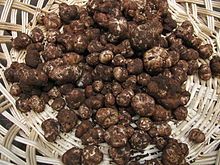Tuber gibbosum
| Tuber gibbosum | |
|---|---|

| |
| Scientific classification | |
| Domain: | Eukaryota |
| Kingdom: | Fungi |
| Division: | Ascomycota |
| Class: | Pezizomycetes |
| Order: | Pezizales |
| Family: | Tuberaceae |
| Genus: | Tuber |
| Species: | T. gibbosum
|
| Binomial name | |
| Tuber gibbosum Harkness (1899)
| |
| Tuber gibbosum | |
|---|---|
| Glebal hymenium | |
| Hymenium attachment is not applicable | |
| Lacks a stipe | |
| Spore print is blackish-brown to brown | |
| Ecology is mycorrhizal | |
| Edibility is choice | |
Tuber gibbosum, commonly known as the Oregon white truffle,[1] is a species of truffle in the genus Tuber.[2] It is found in the Pacific Northwest region of the United States, where it grows in an ectomycorrhizal association with Douglas-fir. It is commercially collected between as early as October and into March.[3]
Taxonomy and phylogeny
[edit]| Phylogeny of Tuber species in the Gibbosum clade, based on ribosomal DNA sequences.[2] |
The species was first described by American mycologist Harvey Wilson Harkness in 1899.[4] The specific epithet derives from the Latin word gibbosum meaning "humped", and refers to the irregular lobes and humps on larger specimens. T. gibbosum is part of the gibbosum clade of the genus Tuber. Species in this clade have unusual "peculiar wall thickenings on hyphal tips emerging from the peridial surface at maturity."[2]
T. gibbosum resembles the similar species T. oregonense, and both are found growing under Douglas fir.

Edibility
[edit]Tuber gibbosum is edible and can be prepared similarly to European truffles; it is typically used to add flavor to a dish.[5]
References
[edit]- ^ Arora, David (1986). Mushrooms demystified: a comprehensive guide to the fleshy fungi (Second ed.). Berkeley: Ten Speed Press. ISBN 978-0-89815-169-5.
- ^ a b c Castellanoi G, Trappe JM, Rawlinson P, Vilgalys R (2010). "Improved resolution of major clades within Tuber and taxonomy of species within the Tuber gibbosum complex". Mycologia. 102 (5): 1042–1057. doi:10.3852/09-213. PMID 20943504. S2CID 27719272.
- ^ Winkler Daniel (2013). "Truffles of the Pacific Northwest". Fungi. 6 (4): 16–19.
- ^ Phillips W, Harkness HW (1899). "Californian hypogaeous fungi". Proceedings of the California Academy of Sciences. 8. 3 (8): 241–291.
- ^ Volk, Tom (1997). "Tom Volk's Fungus of the Month for January 1997". Tom Volk's Fungi.
